PRE-RENAISSANCE ART –
ITALY (~1280-1400)
Before 1800s, the Christian
church was a major influence upon European art, the commissions of the Church, architectural, painterly and
sculptural, providing the major source of work for artists. Biblical themes.
Pre-Renaissance is also followed by “Gothic”, “International Gothic” or
“Proto-Renaissance” styles. Gothic sculpture was born in France in with the renovation of the Abbey Church of
St. Denis (1144). International Gothic describes Gothic art from about 1360 to 1430.
GIOTTO DI
BONDONE (1266-1337)
Beginnings of
secular movement; breakdown of Church power. Di Bondone rediscovers
Fresco painting.
“Mourning of Christ” (c. 1305)
Fresco (Cappella dell'Arena, Padua, Italy)
Key characteristics: depth, space, new spatial approach.

SIMONE
MARTINI
(1284-1344)
“Annunciation with St. Margaret and St.
Ansanus” (1333)
Wooden triptych painted in tempera and gold (Uffizi Gallery, Florence, Italy)
Supporting artist: Lippo Memmi. Influenced by Giotto di Bondone.
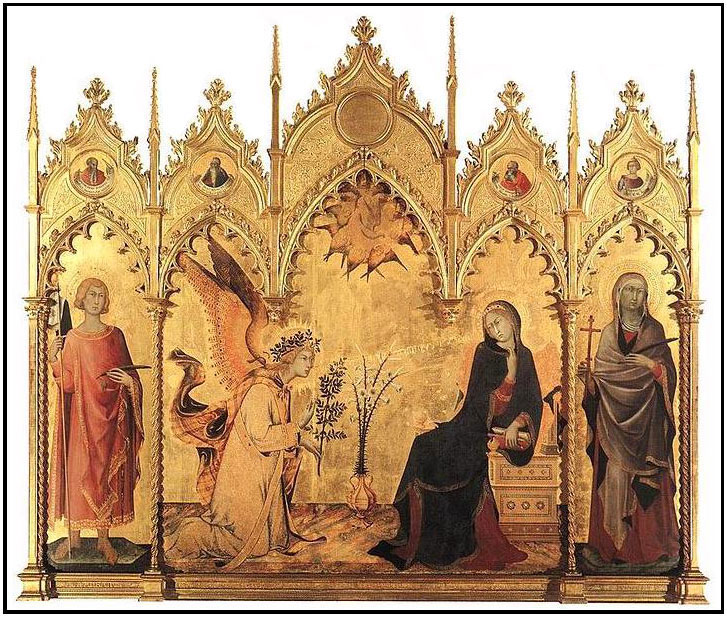
EARLY RENAISSANCE ART –
ITALY (~1400-79)
LORENZO
GHIBERTI
(1378-1455)
Ghiberti was a Floretine artist of the Early Renaissance. The beginning of true
renaissance art can effectively traced back to the 1401 competition for the first set of bronze doors for the
Florence Baptistery. Ghiberti, at age 23, won the contest (Brunelleschi was the runner up). The panels
of the doors depict scenes from the New Testament.
Sculpture: “Gates of
Paradise” (bronze doors).
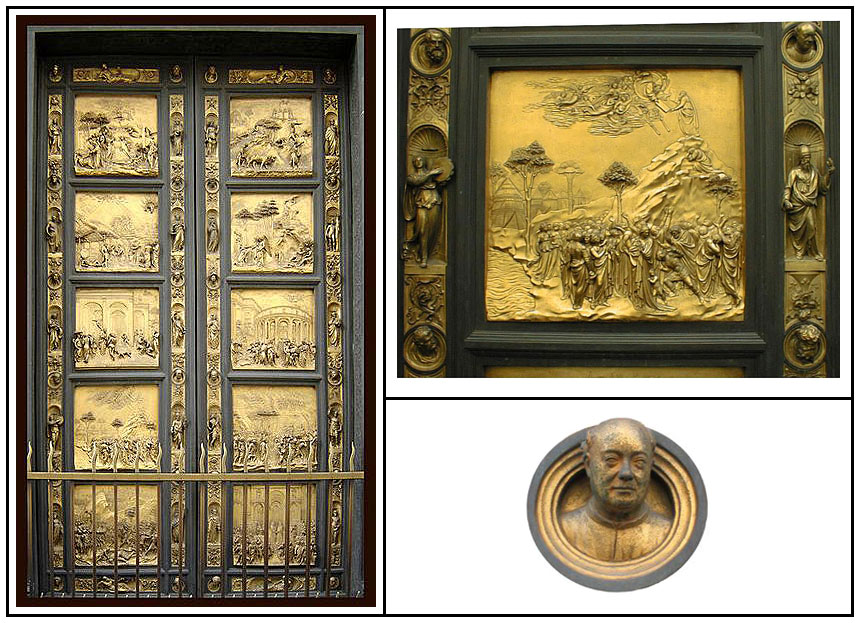
FILLIPPO
BRUNELLESCHI (1377-1446) - The Discovery of Perspective
Architecture: Cathedral of Santa Maria del
Fiorrie (Florence, Italy)
Brunelleschi designs the cathedral’s dome (1420). Develops innovative technique:
perspective (2D on 3D canvas).
Establishes eye level and vanishing point. Major influence in Art (early
Renaissance period).
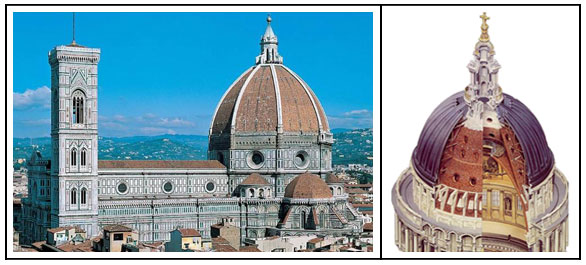
DONATELLO DI BETTO
BARDI
(1386-1466)
Known as ‘Donatello’. Early Renaissance Florentine sculptor. Influenced by
Greek art. Known for his work in bas-relief and creating sculptures and statues with a humanistic touch.
Statue: “St. George” (1420),
“David” (c. 1440s) (Florence,
Italy)
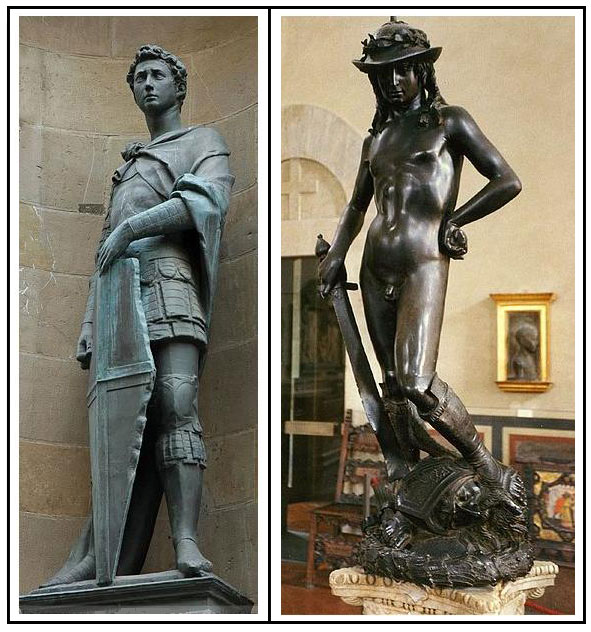
MASACCIO (1401-1428)
Born Tommaso di Ser Giovanni Di Simone. Early great painter of the Quattrocentro
(“1400”) period of the Italian Renaissance. Masaccio took advantage of the new ideas of perspective; great
skill in recreating lifelike figures, movements and convincing sense of three-dimensionality.
“Holy Trinity”
(c. 1427)
Fresco (Dominican church of Santa Maria Novella, Florence, Italy)

PAOLO
UCCELLO
(1397-1475)
Born Paolo di Dono. His nick name Uccello came from his fondness for painting
birds. Florentine painter who was obsessed with the new ideas of perspective and geometry.
Uccello used perspective in order to create a feeling of depth in his paintings.
“Battle of San
Romano” (c. 1435-40)
Egg Tempera with Walnut/Linseed Oil on Poplar: (Uffizi Gallery, Florence,
Italy).
“The Battle of San Romano” is a set of three panel paintings that depict the events
that took place at the Battle of San Romano between Floretine and Sienese forces (1432). Each panel is over
three feet long and are divided between three collections: National Gallery, Uffizi Gallery and the
Louver.

LEON
ALBERTI (1404-1472)
Italian author, artist, architect, Renaissance humanist polymath.
Publication: “On Painting” (1436).
PIERO DELLA
FRANCESCA
(c. 1415-1492)
Italian artist of the early Renaissance; created frescos with perspective with
a feeling of serene humanism. Francesca was probably responsible for the interior design style of the Palace
of Urbino (Marche region of Italy) where the rooms of are "light and airy and perfectly
proportioned".
“Constantine’s Dream” (1455-1466)
Fresco (Church of San Francesco, Arezzo, Italy)
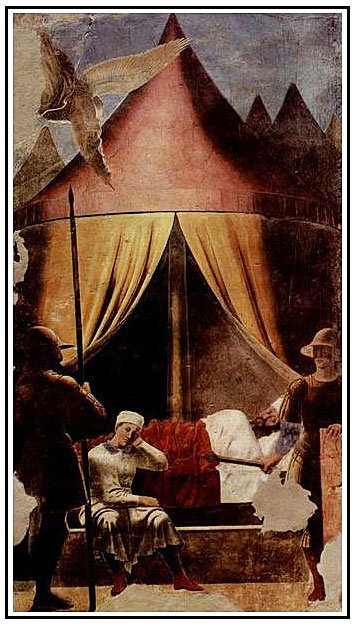
“The Nativity”
(1470-75)
Oil on poplar (National Gallery, London)
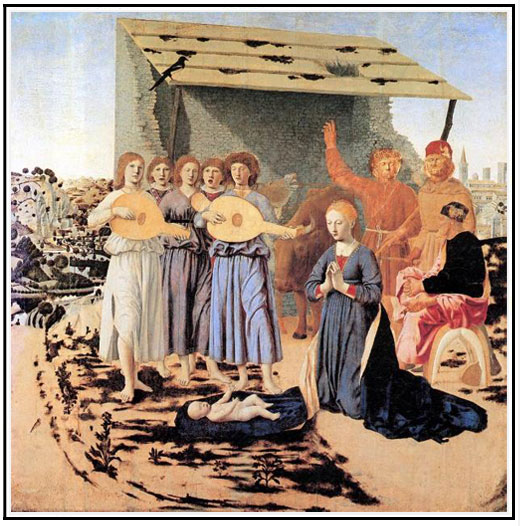
ANDREA
MANTEGNA
(c.
1431-1506)
Italian painter. Noted for perspective experimentation by lowering the horizon
in order to create a sense of greater monumentality.
“The Lamentation over the Dead Christ” (c. 1480)
Tempera on Canvas (Pinacoteca di Brera, Milan, Italy)
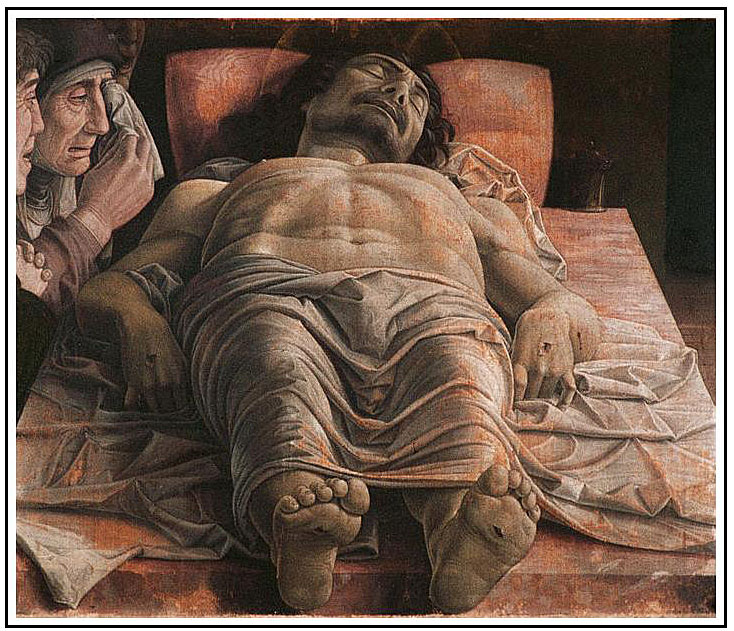
ANDREA DEL
VERROCCHIO
(c.
1435-1488)
Florentine sculptor and painter. Ran workshop in Florence who pupils included
Leonardo da Vinci, Pietro Perugino, Lorenzo di Credi.
Bronze Statue: General Bartolomeo Colleoni
(1483)
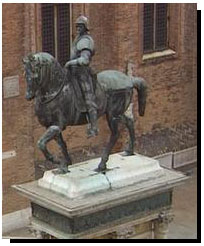
SANDRO
BOTTICELLI
(c.
1445-1510)
Florentine artist of the early
Renaissance. Botticelli did not use the recent innovations of perspective, proportion and anatomy.
Botticelli’s aims in “The Birth of Venus” were more concern with Art than with Science.
“The Birth of
Venus” (c. 1486)
Tempura on canvas (Uffizi Gallery, Florence, Italy)
Depiction of the goddess Venus arriving at the shore after her birth, when she had emerged from the sea
fully-grown. Along with “Primavera”, “Venus” is one of the most famous paintings in the world – an icon of the
Italian Renaissance. It’s treatment of a scene from Greek mythology is straightforward and its appeal is sensory
and very accessible, hence its enormous popularity.

“Primavera”
(late 1470s or early 1480s)
Tempura on panel: (Uffizi Gallery, Florence, Italy)
Primavera translates to 'Spring'. It has been described as "one of the most
written about, and most controversial paintings in the world". The painting depicts a group of figures from
classical mythology in a garden - an allegory based on the lush growth of Spring.

NORTHERN RENAISSANCE
Before 1497 Italian Renaissance humanism had little influence outside
Italy. Artist north of the Alps (Netherlands) were slow to adapt to the new Florentine style; more entrenched
in the Gothic Style – highly detailed.
JAN VAN
EYCK
(c.
1390-1441)
Jan van Eyck was a Flemish painter that pioneered the use of oils (previous medium:
tempura).
“The
Arnolfini Wedding” (1434)
Oil Painting on Oak Panel: (National Gallery, London).
Key characteristics: odd geometric orthogonal perspective (the new system of realistic perspective is absent); use
of a mirror to reflect foreground subjects.
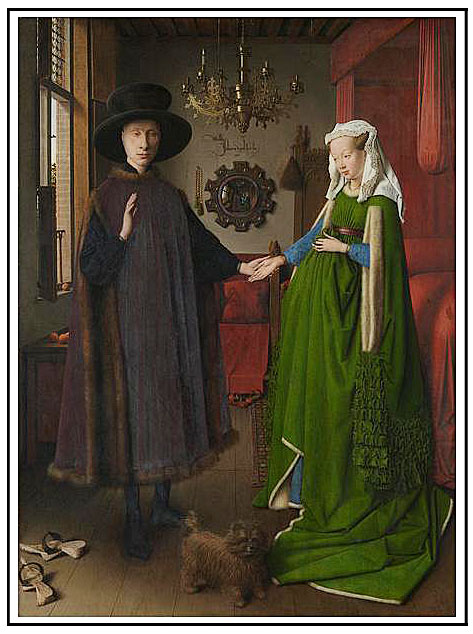
ROGIER VAN DER
WEYDEN
(c.
1400-1464)
Early Flemish painter. Biblical themes (also painted erotic nudes –
lost).
“The Descent from the
Cross” (c. 1435)
Oil Painting on Oak Panel (Museo del Prado Madrid, Spain)

z
|